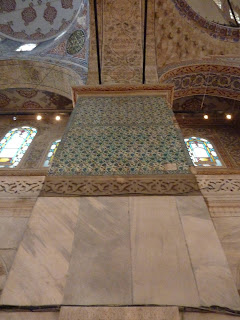According to our guidebook author, Mr. Freely, Eyüp, a town on the north edge of Istanbul is perhaps the third most sacred pilgrimage site in the Islamic world because of its shrine to Abu Ayyub al-Ansari (Eyüp in Turkish) a close friend of the Prophet Mohammed. He died and was buried here in the 670s while leading the first attempt by Islamic warriors to conquer the city of Constantinople.
 |
| Arriving by ferry, the first sight is a grey and green hillside that is an enormous cemetery. |
 |
| In fact much of the town is a necropolis . . . |
 |
| . . . with ordinary tomb markers |
 |
| . . . and with mausoleums (türbes) for those who could afford them. |
 |
| And with pretty little private graveyards too. |
 |
The mosque was built in 1800 after the usual series of earthquakes
damaged the older buildings on the site. |
 |
Unlike the mosques we visited yesterday, this one was bustling with religious activity.
Pilgrims were evident in the busy courtyard.
We were permitted to enter the mosque and stand in the visitor area,
but because there was a service in progress with a sermon, men kneeling in prayer,
and women gathered in their galleries, photographs were not permitted. |
 |
| The Sadirvan for ritual washing in the center of the courtyard. |
 |
| And additional taps for men to wash around the walls. |
 |
Like so many sites, the sacred Türbe of Ayyub was closed for building works.
The dome is visible in the center of the picture. We were able to walk through a passage past a window
where many pilgrims were praying. Once again photos did not seem appropriate.
The tomb was built in 1458, shortly after the successful conquest. |





















































